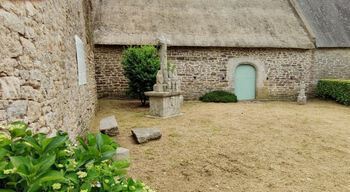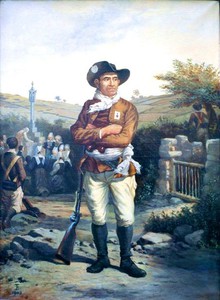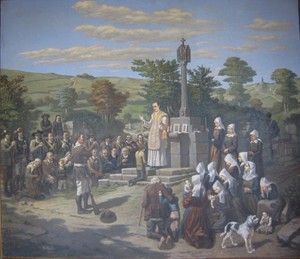Discovery of the Breton « chouanerie »
 Created in 1990, the association bought the ruined house where Pierre GUILLEMOT was born in 1759.
Created in 1990, the association bought the ruined house where Pierre GUILLEMOT was born in 1759.
It was renovated to evoke what a wealthy peasant's farm could have been like at the end of the 18th century and the beginning of the following century with its thatched roof and basic furniture.
The association wanted the cottage, inaugurated in 2010, to become a museum where exhibitions on the Chouannerie and local history have been held every summer for seven years.
Opening and rate 2025
Summer 2025 exhibition : The small Chouanneries of 1815 and 1830 and Julien Guillemot.
Open to the public every Saturday and Sunday from 2 pm to 6 pm, in July and August and on the European Heritage Days.
For groups, 15 people minimum, from the 1st Saturday in July to October 15th, by appointment.
Free entrance. Free or accompanied visit.
The birthplace of Pierre Guillemot
Kerdel 56500 BIGNAN
Phone : 06 64 65 28 93
Learn more on the Chouans
Pierre Guillemot, “Rouë Begnen” the King of Bignan

Pierre Guillemot was born on November 1st 1759 at the farm of Kerdel in Bignan. Married, a father and an educated man, he studied at the Collège St Yves in Vannes, Guillemot was not hostile to the first ideals of the revolution and was even elected attorney-trustee of Plumelec, where he settled after his marriage.
In 1792, Pierre Guillemot returned with his family to exploit the land of Kerdel. But in March 1794, noting the excesses of the revolutionaries, especially in religious matters, he raised the whole country of Bignan and its surroundings. Hunted, Pierre Guillemot and his family must abandon this farm which will be plundered and sold as national property.
The nickname "King of Bignan" is given to him by both his friends and the Republicans. His kingdom stretches over more than 50 parishes and his legion will number up to 4,000 men, which testifies to the large mobilization of the peasant population within the chouannerie in the department of Morbihan.
Named colonel of the Catholic and Royal Army, he is, with Georges Cadoudal, the most popular and respected leader of Morbihan chouannerie. Betrayed, he was arrested in Plaudren and tried in Vannes by a military commission. He was executed on January 5, 1805 on the esplanade de la Garenne in the same city.
Why the revolt, the chouannerie ?

Lors de la Révolution française, dès 1790, les secteurs de Locminé et Saint Jean Brévelay, comme leurs voisins du Morbihan se révoltent contre la République. C'est ce qu'on appelle la chouannerie ! Attention, il ne s'agit pas ici de la chouannerie de Vendée, plus connue et plus meurtrière mais bien de la chouannerie bretonne, celle des paysans de l'Ouest de la France qui prennent les armes pour s'attaquer aux Bleus, les gardes nationaux de la République.
The rural world (80% of the population) was initially in favour of the Revolution of 1789, which was to remove it from feudalism and bring a wind of freedom.In 1790, however, the revolutionaries' excesses, especially in the religious field, began to put doubt in the minds. The Civil Constitution of the clergy wanted to make priests officials by obliging them to take the oath. The refusal to take this oath and the ensuing repression set this world on fire. The sale of the goods of the church and of the emigrants as a national good, mainly for the benefit of the revolutionary bourgeoisie, accentuated discontent.
In 1793 the raising of 300,000 men had to designate by «draw» the men to go to war.
But the draw is not equal: not only judges and members of municipalities, districts or departments are excluded, but in addition, the wealthy pay for others to take their place.
The peasants saw this as privileges which they believed had finally been abolished since 1789 and all these elements led to armed revolt: the Chouannerie (*). This spirit of revolt will persist for nearly half a century on the territory.
(*) The chouannerie owes its name to Jean Cottereau, named Jean Chouan. These men used the owl’s cry to recognize themselves.





